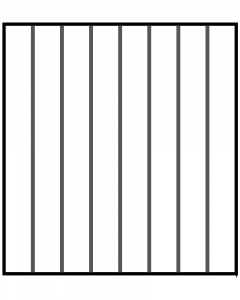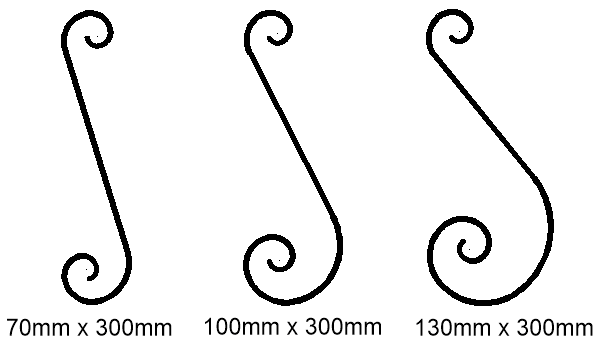bar gaps.
The spacing between upright bar and the number of upright spindles is not constant. Its all going to depend on the size of the gate. This applies to single and double gates

Gate frame for a 900mm opening with 7 upright bars
If we take a 915mm (3ft) wide gate, space for hinges and latch take about 115mm from the size. Meaning the frame is 800mm wide. If we want to keep a central upright bar in a gate. Allowing a centre piece or central design, an odd number of bars are needed. In a 915mm gate 7 uprights is a good number.
7 uprights mean we have 8 gaps. To find the gap between each bar. Just divide the frame size by 8 (the gap number). 800 divided 8 is 100. So you have a gap size of 100, but you are using 12mm upright bars. Therefore you need to take bar thickness away from gap size. 100 – 12 = 88. You have a gap between each bar of 88mm.
Increase the gate opening size to a little over 1000mm. You have a frame size of 900mm. divide 900 by 8 and subtract bar thickness. you get 100mm between bars. This is all very obvious as the gate gets wider so do the gaps. But what sometimes gets missed is that if the purpose of the gate is to keep a pet in. There comes a point where the gap is to wide to do it. A German Shepard is never going to get through a 100mm gap. But a Yorkshire terrier possibly will.
The obvious answer here is add an extra bar, close up the gaps. In an ideal world its away nice to have an odd number of bars (even number of gaps). This gives a centre bar, and ideal central position to start a design from. To keep that centre bar you have to add 2 bars. Our 1000mm wide gate with its 900mm frame size. Is now 900 divided by 10 gaps (9 upright bar) or 90mm less of course the thickness of our bars (12mm). Our gap between bars becomes 78mm. No escaping through the gate now for the Yorkie.
Of course more upright bars are more work, extra bars to cut and extra to weld and that increases the base price. Increasing the frame size but not increasing the bar count doesn’t really increase the work just the material content required for the frame. Sometimes the cost increase is so small its not worth having a different price if the upright bar count is the same. A 900mm wide gate is a 1000mm gate as far as price goes.

There is a bit of a spoiler here, in life there always is. S scrolls ideally need a good gap to span. The narrower the gap the more squashed or distorted the scroll becomes.
On the 70mm version its almost hard to see the difference between the head and the tail. At 100mm the head is noticeable larger than the tall. At 130mm the difference is very noticeable. Looking back at the bar designs the width of the gap means it wont look exactly like those bar designs, as S scrolls vary slightly according to width.